- Bigbikemad Home
- Bike Reviews
- Product Reviews
- Clothing Reviews
- Videos
- Tech.Topics
- Memories
- Sounds!
- Contact Us
- Three Bikes in Three Summers: Touring in Ireland
- Kawasaki ZZR1400 ZX14 Project Page
- Scottolier V System Install on Kawasaki ZZR1400
- LED Running Lights ZZR1400
- Motorcycle Airbags
- News Offers, Discounts, and Stuff
- Legal Eagle
- Oxford Digi-Gauge Tyre Pressure Gauge
- So You've Had An Accident ...
- FJ 1200 Review
- Write It Down!
- Rukka Argonaut Trousers
- Untitled
- TCX X Desert GTX Boots
- Urban Cowboy? We take a look-see at BMW's F700GS
- Untitled
- Motorcycle Heaven; Ireland on a ZZR1400 - 2014 Tour Report
- Harley Davidson Fat Bob - Review
- Harley Davidson V-Rod - Project Page
- Triumph Rocket III - Project Page
- Ta-Ta Tax Disc
BMW S1000RR and BMW K1600GT Real World Winter Test
Taking two of BMW’s best beyond their comfort zones
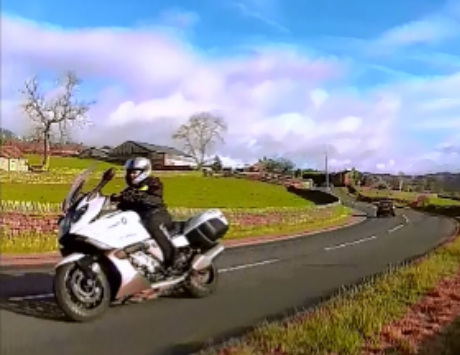
The BMW S1000RR and BMW K1600GT make an unlikely pair; in the red corner; the fastest fire-breathing sportsbike and in the blue corner, the heavyweight sofa-on-two wheels that is the K1600GT SE. But we’re not only mad enough to twin them together in the same test, we’ve also taken them well outside their comfort zones; away from the exotic race tracks and the palm-lined sun-kissed sweepers of posh press launches, to a real world destination strewn with gravel, tractors, itinerant sheep, potholes and the kind of greasy muck that only British roads in winter can provide. Good-bye advertising commercial and hello real world.
There is method in our madness, and it’s this; we can all dream of taking a plush tourer across the US or perhaps blasting Silverstone on a cool sportsbike, but for most of us, much of the time our ride routes will be less glamorous and closer to home.
Also, unless we have the luxury of multiple bikes or are willing to wrap our beloved machines in cotton wool over winter, we have to ride beyond the strict design envelope of our mounts and in less than ideal conditions. The questions we wanted answers were these; can such apparently specialised machines as these two admittedly extreme examples really be practical in everyday life? And is technology a help or a hindrance in pushing such bikes way beyond their design limits?
There is method in our madness, and it’s this; we can all dream of taking a plush tourer across the US or perhaps blasting Silverstone on a cool sportsbike, but for most of us, much of the time our ride routes will be less glamorous and closer to home.
Also, unless we have the luxury of multiple bikes or are willing to wrap our beloved machines in cotton wool over winter, we have to ride beyond the strict design envelope of our mounts and in less than ideal conditions. The questions we wanted answers were these; can such apparently specialised machines as these two admittedly extreme examples really be practical in everyday life? And is technology a help or a hindrance in pushing such bikes way beyond their design limits?
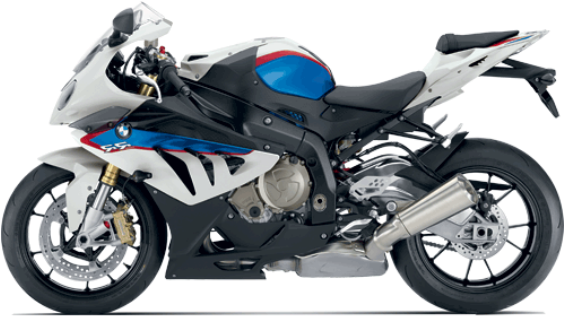
We wanted to know if the S1000RR is just a toy or whether you can still enjoy riding it on muck strewn winter roads and still feel safe. Just how unflustered would the massive K1600 remain when the roads are less than arrow straight and billiard table smooth? Will either bike handle the abrupt dips and double radius curves of the Dales notoriously undulating lanes? Taking both bikes out of their natural habitats like this seemed a good way to find out just how good the technology really is.
God’s County
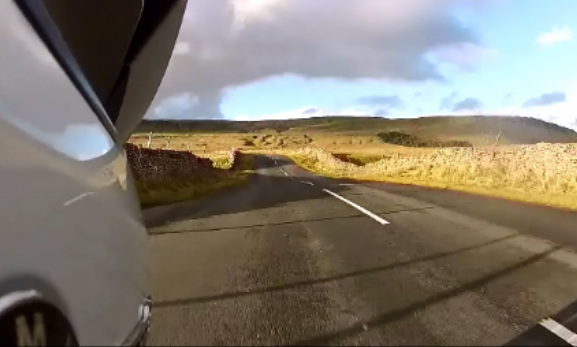
We picked up our bikes from Allan Jefferies BMW in Shipley and set off for the majestic scenery of the Yorkshire Dales National Park. The route chosen included sweeping A and B roads as well as more twisty, stone walled lanes over the top of the Park. Happily we were blessed with golden sunshine, making it easy to see why locals call West Yorkshire ‘God’s County’, but sitting astride over thirty grand’s worth of machinery, we were acutely aware of the tarmac glistening, wet with a treacherous greasy sheen.
It wasn’t long before urban streets fell behind us and we emerged onto stunning scenery bathed in glowing light through which the road coiled like a shining black ribbon. We began gently; fast A-roads with long straights punctuated by glorious sweeping curves – well within the design envelopes of both machines. Then narrow sunken lanes with stone walls giving an almost TT feel. The surface became scarred with pot holes, bends tighter and more numerous. Farm entrances, glistening with tyre-spinning muck, caused many a tense moment as tractors lurched forward ready to end our progress either with or without extreme prejudice.
It wasn’t long before urban streets fell behind us and we emerged onto stunning scenery bathed in glowing light through which the road coiled like a shining black ribbon. We began gently; fast A-roads with long straights punctuated by glorious sweeping curves – well within the design envelopes of both machines. Then narrow sunken lanes with stone walls giving an almost TT feel. The surface became scarred with pot holes, bends tighter and more numerous. Farm entrances, glistening with tyre-spinning muck, caused many a tense moment as tractors lurched forward ready to end our progress either with or without extreme prejudice.
Ride, Handling and Power

S1000RR
There are those that say sportsbikes like the S1000RR have no place on British roads. They are expensive and impracticable toys, and only on the track can you unleash their full potential. According to one writer just last month commenting on the S1000RR; ‘ they’ve built a race bike and stuck lights on it.’ He complained; ‘…It’s less than great in traffic and on bumpy back roads….’
Clearly, that particular guy has never ridden one and in any case no one has told BMW’s designers their bike should only be any good on track. True, the bike will accelerate faster than an MP filing an expenses claim, the on-road rush a glorious experience of wailing exhaust and blasting air so intense you simply forget to breathe. The small Beemer also corners as though held to the road by invisible magnets, yet can change line faster than a vector-jet weasel. In these respects the 2012 vintage is noticeably sharper than the original. Top speed is knocking on the door of 200mph and the UK’s national limit can be exceeded in first gear. But this is all missing the point. The bike’s real trick, and where the technology scores, is elsewhere.
Riding Machine
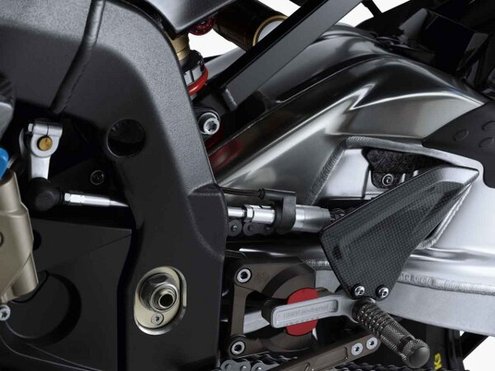
The rear swing arm is a sculpted mass of aluminium beauty… Gorgeous engineering…
What BMW have done is very clever. Technology, from the quick shifter to the radial brakes, has been used to make the bike go fast and stop fast. But the BMW guys haven’t left it there. Remember BMW gained its reputation in cars by making them driving machines – Fast, yet practical and also safe. Its the same thinking with the S1000RR. The bike is race winningly fast yet astonishingly usable. It took a while for safety to sell in cars, perhaps now we as riders are ready to accept it on two wheels too. Its good safety too – not crude like earlier aids. Feedback is excellent, with powerful braking of both machines, hauling the metal up rapidly and with no more fuss than a slight pulsing of the levers.
Ride quality on the potholed back lanes is ridiculously smooth and pliable, grip is astonishing and agility is as useful around town as on track. Only the worst pot-holes unsettled the RR, and then only for fractions of seconds. The main limitation in town is the rather limited steering lock available, but the bike is feather-light and can easily be muscled through any three point turns if needed. Rider position is much less cramped for the average rider than on say a ‘Blade. Above all you get the feeling that the bike is taking care of you. A few times we experienced that cringing ‘I’m-heading-for- that-drain-cover-at-the apex-too-fast-and-too-cranked-over’ feeling only to sail over without a moment’s hesitation or loss of grip. Once we stopped, went back and checked because we couldn’t believe what we’d just done. This bike is likely to provoke insane giggles.
Engine
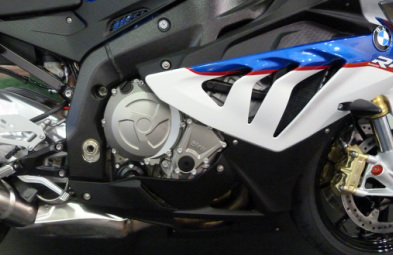
The leap forward in technology is equally obvious in the S1000RR’s engine department. Ride below about 7,000 rpm and you are rewarded with a clean pulling, controllable response, even in ‘rain’ mode. There is no hesitation, no stutter, just straight predictable power; enough yet not too much, say about the same as a 1000cc naked. Usability (relaxed overtakes and fewer gear changes) are made possible by improved low and mid-range torque on the 2012 model. Above 7,000 rpm it’s a different story, becoming ever more demented as you head for the red line and the shift indicator flashes, but the transition is smooth.
BMW have given you a choice. Commute to work (using the heated grips if cold) and stay out of trouble, or deliberately seek thrills. The choice is yours and the throttle really does go both ways. It’s just as it should be; docile and friendly when you need it to be and chainsaw mad when you need to carve past the traffic or try kissing the horizon. So responsive was it, so quick to change personality, it felt like playing a video game where a button changes a character’s identity at will.
BMW have given you a choice. Commute to work (using the heated grips if cold) and stay out of trouble, or deliberately seek thrills. The choice is yours and the throttle really does go both ways. It’s just as it should be; docile and friendly when you need it to be and chainsaw mad when you need to carve past the traffic or try kissing the horizon. So responsive was it, so quick to change personality, it felt like playing a video game where a button changes a character’s identity at will.
Quality Ride and Comfort – on a sportsbike..
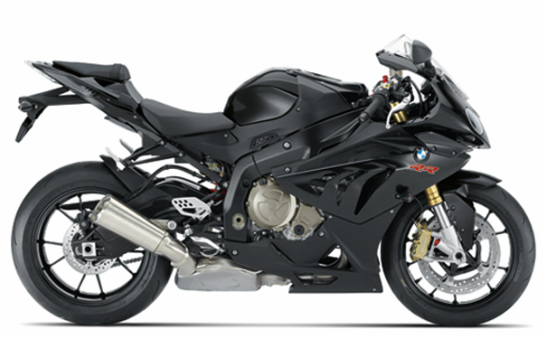
It’s the same with the handling. Roads were far from ideal, so we set the bike up at moderate levels of damping and preload and put in into ‘sport’ mode (number 3 of 4 modes, 1 being the most hairy). All too aware of the Beemer’s 193bhp, our Graham approached the first corners with some trepidation. But quickly it sank in that wider throttle openings and greater lean angles had little effect on stability or grip.
Nor did the bumps and gravel patches of a country road. ‘It’s just so easy to ride’ he said at our first coffee stop – gazing at the diminutive red white and blue machine and shaking his head as though he couldn’t believe it.
‘ I’ve got it in sport mode – which is still full power, but with a good dollop of traction control, and it’s as stable as on a track. Nothing happens unless you want it to, even on patches of wet cow‘s muck. Like John Luc Picard saying ‘make it so’, and it is’.
Rider protection and comfort were also surprisingly good. The fairing did an unexpectedly good job of deflecting muck and rain and the cockpit was roomy for a sports bike. Un-cramped and with refinements like heated grips.
‘You could even commute on it’, said Graham, mentally checking his bank balance, ‘it doesn’t put too much weight on your wrists.’ ‘And its pretty too…the front is like an arrow head, the swing arm is pure sculpture and the sides are so streamlined. It’s poised, ready to spring, but so delicate – it reminds me of the Daytona in that way.…’ He’ll have the red and white one then.
Nor did the bumps and gravel patches of a country road. ‘It’s just so easy to ride’ he said at our first coffee stop – gazing at the diminutive red white and blue machine and shaking his head as though he couldn’t believe it.
‘ I’ve got it in sport mode – which is still full power, but with a good dollop of traction control, and it’s as stable as on a track. Nothing happens unless you want it to, even on patches of wet cow‘s muck. Like John Luc Picard saying ‘make it so’, and it is’.
Rider protection and comfort were also surprisingly good. The fairing did an unexpectedly good job of deflecting muck and rain and the cockpit was roomy for a sports bike. Un-cramped and with refinements like heated grips.
‘You could even commute on it’, said Graham, mentally checking his bank balance, ‘it doesn’t put too much weight on your wrists.’ ‘And its pretty too…the front is like an arrow head, the swing arm is pure sculpture and the sides are so streamlined. It’s poised, ready to spring, but so delicate – it reminds me of the Daytona in that way.…’ He’ll have the red and white one then.
Brakes, ride and grip
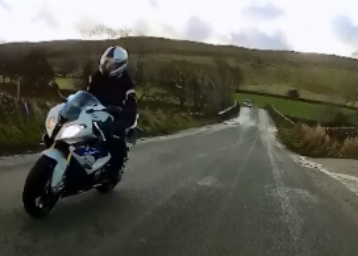
Then there are the brakes. We may be rather sad for getting excited by a tangle of tubes wires but, trust us; these stoppers will put a grin on your face as much as the rorty exhaust note will. Heading into a tightening bend a bit fast? No problem, just a quick squeeze on the front and then trail brake with the rear if needed. Speed scrubs off so fast it’s almost like being able to press rewind. The front 320mm discs with four-piston Brembo mono-bloc radial calipers are simply awesome. Combined with the fluid suspension they add to the joy because they work powerfully but without fuss. Braking using the race ABS can be later and power on earlier, or, if you wish you can just enjoy a gentle bimble; confident in the knowledge that you have huge reserves of safety left. And that’s what the S1000RR does best. It gives you all the performance you could wish for, but it copes with slithery uneven surfaces, unexpected tractors and still makes you feel safe.
The greatest test for both bikes came when the K1600’s sat nav sent us down what turned out to be something of a mud track. It was impossible to turn around so, we put the electronic guardian angels on a higher state of alert and just carried on. On the S1000RR we selected ‘rain’ power mode, and on the K1600 the rather choppy ‘sport’ ESA setting was backed off to ‘normal’ with engine power down to ‘rain’ – all selectable through the knurled adjuster ring and digital screen menu. On pure mud you could just feel the rear end of the S1000RR slipping slightly, but it was very slight, and thankfully we reached a made up road within a few hundred metres. The huge K1600 was completely unperturbed. (See Videos Here)
The greatest test for both bikes came when the K1600’s sat nav sent us down what turned out to be something of a mud track. It was impossible to turn around so, we put the electronic guardian angels on a higher state of alert and just carried on. On the S1000RR we selected ‘rain’ power mode, and on the K1600 the rather choppy ‘sport’ ESA setting was backed off to ‘normal’ with engine power down to ‘rain’ – all selectable through the knurled adjuster ring and digital screen menu. On pure mud you could just feel the rear end of the S1000RR slipping slightly, but it was very slight, and thankfully we reached a made up road within a few hundred metres. The huge K1600 was completely unperturbed. (See Videos Here)
K1600GT SE – Special K?
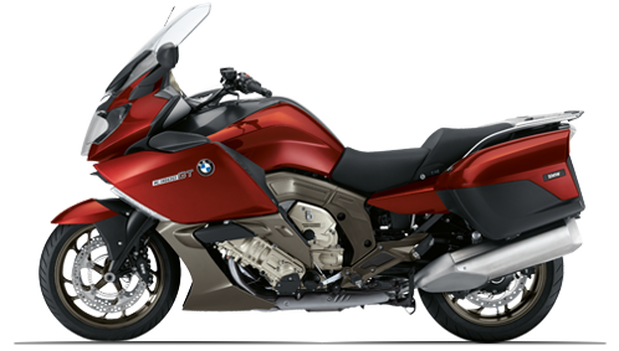
First impressions of the GT were of a very large and somewhat unwieldy looking beast – truth is we were more worried about taking this for a muddy country blast than we were the S1000RR.
We needn’t have worried. Weight – in the form of slight top heaviness with a full tank – only becomes apparent at slow speed with plenty of steering lock on. Most of the time it’s a doddle, with the apparent bulk disappearing as soon as your feet leave the floor.
We needn’t have worried. Weight – in the form of slight top heaviness with a full tank – only becomes apparent at slow speed with plenty of steering lock on. Most of the time it’s a doddle, with the apparent bulk disappearing as soon as your feet leave the floor.
Up and down Dale
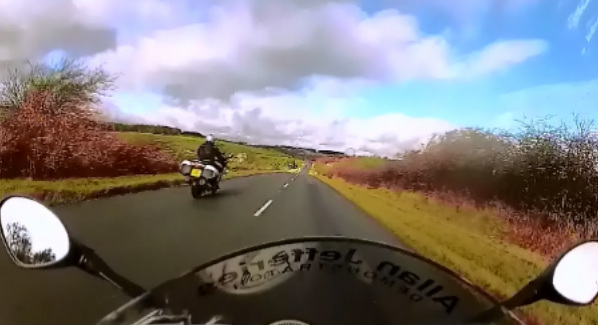
The fast, almost traffic free main roads through the Dales proved to be real K1600 territory, and in Normal or Sport ESA modes and engine switched to the middle setting of ‘Road’, the great beast delivered a plush ride, yet devouring bends with an agility that belied its size. On tighter corners noticeably more rider input was required as the sheer mass began to tell, but it’s easily dealt with once you learn what the bike needs. Adapt and increase the inputs accordingly. No one would buy this expecting sportsbike handling, yet when ridden with enthusiasm, the much faster S1000RR could not quite shake it off, which was astonishing. We put it down to the smart duolever on the K1600, which allowed trail braking in corners and exceptional stability when heeled over.
Both bikes have engines much dissected in the biking press; the S1000RR boasting the highest output of any litre sports bike, and the K1600, as indicated by the proud ‘6’ badge, a massive in-line six. It’s also the lightest 6 ever made at 102.6kg. As you’d expect, both are ultimately designed to do different things; the job of the 1000’s four being to propel you like a SAM missile from launch, while the Tourer’s multi-valve six aims at delivering silky smooth power and tree-stump-pulling torque without tiring vibration.
Both bikes have engines much dissected in the biking press; the S1000RR boasting the highest output of any litre sports bike, and the K1600, as indicated by the proud ‘6’ badge, a massive in-line six. It’s also the lightest 6 ever made at 102.6kg. As you’d expect, both are ultimately designed to do different things; the job of the 1000’s four being to propel you like a SAM missile from launch, while the Tourer’s multi-valve six aims at delivering silky smooth power and tree-stump-pulling torque without tiring vibration.
Time for a six-pack…
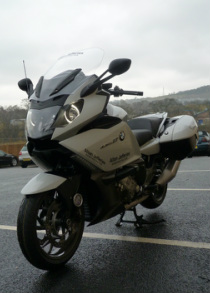
The K1600GT’s mighty mill does not fail to deliver plenty of grunt, though ‘rain’ mode is a tad too relaxed. In ‘road’ or ‘dynamic’ however it shifts the bike swiftly and, when necessary with blistering speed. Fourth gear overtakes were especially rewarding. Yet it was the least involving engine, and that’s not just because of its intended role as tourer. The problem is that, like a two-wheeled George Clooney, it’s almost too smooth for its own good. Power delivery in ‘rain’ – the least aggressive of the three selectable engine maps – is linear and without an invigorating rush despite the massive amount of toque available. Open the throttle and it goes faster, but in the same way a car responds. It’s a tad too predictable, too safe. Things are livelier in ‘road’ and perkier still in ‘dynamic’, but delivery is still car-like – albeit like a rapid sports car.
On the other hand, the tourer was the most relaxing to ride; overtakes can be accomplished in the upper gears just by a twist of the wrist, and bends can be taken fast in any of the middle gears. This flexibility and smoothness was an asset in winter conditions, helping keep the tyres unstressed and firmly planted. Things were not so great at town speeds however, when the high centre of gravity of the Big K made its self felt when weaving in and out of traffic. It’s not a real issue though and you’d get used to it.
On the other hand, the tourer was the most relaxing to ride; overtakes can be accomplished in the upper gears just by a twist of the wrist, and bends can be taken fast in any of the middle gears. This flexibility and smoothness was an asset in winter conditions, helping keep the tyres unstressed and firmly planted. Things were not so great at town speeds however, when the high centre of gravity of the Big K made its self felt when weaving in and out of traffic. It’s not a real issue though and you’d get used to it.
A nice place to be…
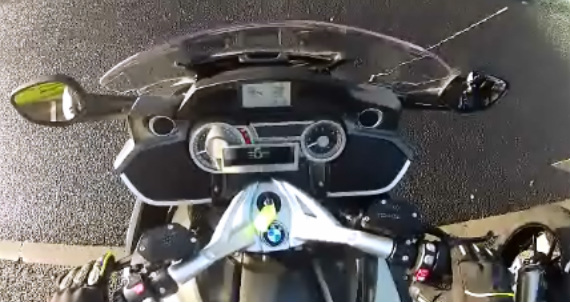
There’s no doubt that the cockpit of the Big K is a great place to be. The display – though complicated – is clear and the electrically adjustable screen, combined with cunning side deflectors helps you create the right micro climate with assistance from dual heated seats and grips if required. The fairing does a great job of deflecting winter rain and muck.
It’s an imposing yet comforting space with a pleasingly upright but relaxed riding posture, customisable by adjustable seat height. You really do feel that on this beast you could travel the world – and in considerable style. Luggage is of impressive capacity, though we did not have the capacious top-box fitted. Quality and water tightness were excellent.
Ride quality on the bigger Beemer was equally impressive and is bound to please pillions (and a happy pillion equals a happy rider as anyone who has taken their Dearest Other away for a weekend knows). We tried it on potholes, gravel and deep ruts in mud and tarmac and it was never anything less than cashmere-codpiece smooth. There can be no doubt that this would be great to cover the miles, and on smoother roads the only danger would be falling asleep. However it also transported a rider and camera and wet weather gear around on a stop-start winter journey through town and country faultlessly and would equally double as a fine, if incredibly sumptuous commuter.
At speeds above walking pace the technology gives you the same reassuring support as on the RR – like a benevolent angel; not interfering but just gently catching you when you go too far. This is especially noticeable (or rather not noticeable as operation is seamless) with the DTC traction control which prevented any significant slippage despite repeated provocation on gravel, mud and water over 6 inches deep. Amazing.
It’s an imposing yet comforting space with a pleasingly upright but relaxed riding posture, customisable by adjustable seat height. You really do feel that on this beast you could travel the world – and in considerable style. Luggage is of impressive capacity, though we did not have the capacious top-box fitted. Quality and water tightness were excellent.
Ride quality on the bigger Beemer was equally impressive and is bound to please pillions (and a happy pillion equals a happy rider as anyone who has taken their Dearest Other away for a weekend knows). We tried it on potholes, gravel and deep ruts in mud and tarmac and it was never anything less than cashmere-codpiece smooth. There can be no doubt that this would be great to cover the miles, and on smoother roads the only danger would be falling asleep. However it also transported a rider and camera and wet weather gear around on a stop-start winter journey through town and country faultlessly and would equally double as a fine, if incredibly sumptuous commuter.
At speeds above walking pace the technology gives you the same reassuring support as on the RR – like a benevolent angel; not interfering but just gently catching you when you go too far. This is especially noticeable (or rather not noticeable as operation is seamless) with the DTC traction control which prevented any significant slippage despite repeated provocation on gravel, mud and water over 6 inches deep. Amazing.
Technology: The Good, the Bad and the Useful
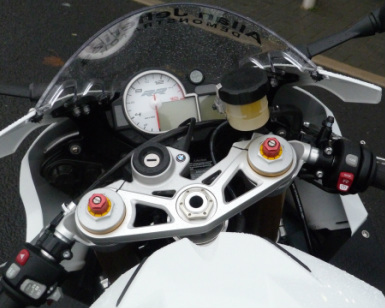
During a mid-morning cuppa to swap notes it wasn’t engines or ride that dominated conversation but the sheer amount of technology oozing from both bikes. It seems like manufacturers have gotten themselves dragged into an escalating arms race – vying with each other to offer more toys to tempt buyers. Nowadays a tourer is not a tourer without sat nav, ESA and heated seats, and every sportsbike has to have switchable modes and traction control. It’s a far cry from the days when sportsbike meant putting some clip-ons and a noisy pipe on yer old Jap four.
The gadgets and gizmos fell into two camps. On the one hand, most people would welcome safety aids providing these could be switched off and providing they enhanced and did not restricted riding. In this sense ABS, engine maps and traction control on both bikes were superb. Said Graham, ‘It’s like having a gangster big brother taking care of business for you. No, no, Mr Slippery Road, you do not mess with this guy, capiche?’. Blimey, anyone would think this guy wants to be a journalist.
We were less sure about the plethora of trinkets on the K1600GT. Unlike Triumph, who have opted for clusters of switches to handle all the options, BMW has instead gone for a knurled selector wheel and a couple of buttons linked to an LCD display. This does eliminate the clutter, but we found it tiresome and confusing to use, and a real distraction on the move.
No doubt that many of the features are desirable on a tourer – from Bluetooth sat nav to heated grips and seat there were many useful comforts. But do we really need a radio, adaptive headlight and central locking?
The S1000RR was less burdened by baubles, but even here we felt that things were starting to move in the wrong direction form-over-function wise. The display was a case in point, where numerous tiny LEDS fought for rider attention. Nothing seriously wrong with either bike – just perhaps trying too hard. The basic rideability of the bike is what counts and extras that might look good on paper can result in unwelcome complexity in real-world conditions.
Living with them
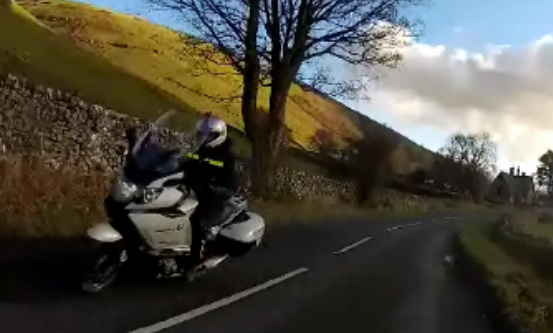
Our winter test was all about practicality and one thing is abundantly clear; both bikes are great real world machines, capable of a lot more than simply carrying out their main role. In this sense BMW’s clever technology has triumphantly succeeded in letting us have our cake and eat it. Each bike is effectively several bikes for the price of one. The tourer is manageable enough to use for a Sunday blast or commute and can handle slippery winter roads thanks to advanced ABS and the DTC traction control, the sportsbike capable of delivering entertainment on real world roads with levels of comfort and wind blast protection that would have been unthinkable even a few years ago. Build quality looks good enough to survive all year round use subject to proper cleaning and maintenance.
It’s early to be definitive about reliability, and there have been stories of engine troubles on the RR (though quickly sorted under BMW warranty). Clearly not enough to stop it topping the sales charts though. Service intervals are 6,000 miles on both bikes, which is acceptable, but not as good as the 10,000 miles offered by Triumph.
Fuel consumption is fantastic on the RR, considering the power output, but only reasonable on the K1600 – where the frictional losses of 6 cylinders make themselves felt. Tank size on the tourer is also disappointing at 24 litres, giving a maximum tank range of around 200 miles.
Build quality is very good on key components – brakes, suspension and running gear on the RR are like works of art – enough to get any buyer drooling. The K1600 also has a quality feel, especially the paintwork and broad, comfortable seat. Detailing though was less satisfactory on the S1000RR – some of the plastic around the tank was flimsy looking and really should be carbon fibre on a bike of this price. Similarly the tail lamp seemed to follow form not function and looked thin and fragile. Paintwork was good on both bikes – thick with a quality shine.
The Verdict
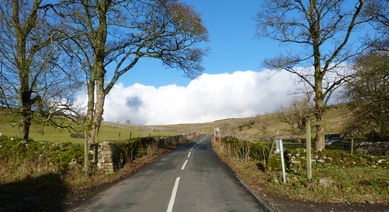
Technology – of the right type in the right place – can transform motorcycling. In these two cases BMW’s clever thinking enabled us to ride two powerful machines under extremely tricky conditions with a margin of safety unimaginable a decade ago. It felt so easy, and through that sensation came enhanced enjoyment. The versatility of these bikes and that friendly feeling, even under winter conditions, will dramatically extend riding range and season for many riders. In both cases the technology then basically delivers several bikes in one. And so the drugs do work. Awesome!
BMW S1000RR 2012 Vital Statistics
|
Engine Power Weight Drive Acceleration Top Speed Fuel Capacity Fuel consumption Service intervals Cost Now BBM Rating |
999cc, in line, 16 valve, liquid-cooled four 193bhp / 83 lbs/ft 204 kg Chain 0-60 in 2.8 secs 190 mph? 17.5 litres 40 mpg (depends a lot on how ridden and rises as engine beds in) 6,000 miles £ 12, 295 (Plus £1335 Race ABS + DTC, £230 for heated Grips and £330 for quick-shifter) ***** |
BMW K1600GT SE Vital Statistics
|
Engine
Power Weight Drive Acceleration Top Speed Fuel capacity Fuel consumption Service intervals Cost Now BBM Overall Rating |
1649cc, Liquid-cooled, 16 valve, DOHC, in-line four
161 bhp / 129 ft/lbs 319 kg Shaft 0-60 3.6secs 155 mph 24 Litres 41 mpg average 6,000 miles £16,660 (Plus £750 for ESA) **** |
BMW K1600GT BMW S1000RR